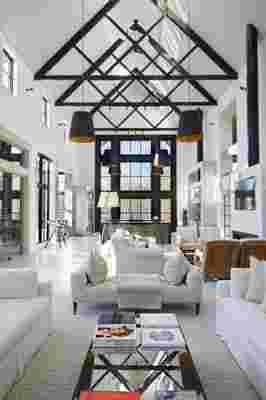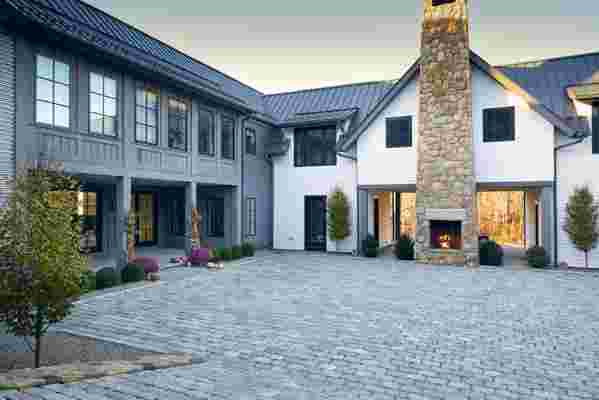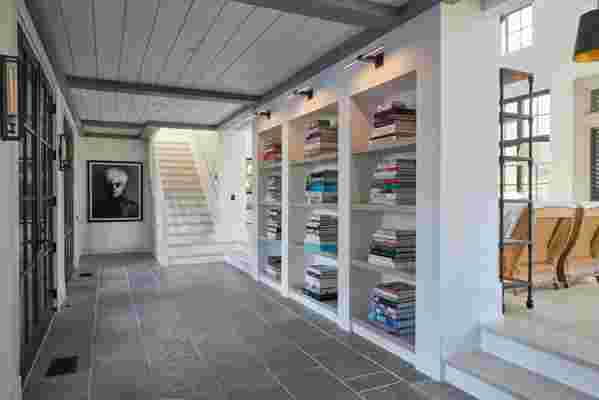Like so many modern relationships, the New Canaan, Connecticut –based architecture firm Brooks & Falotico and their soon-to-be client, Tyler Mitchell, met through social media. Mitchell, a partner and co-owner of Mitchells , his family’s generations-old retail business, and his wife stumbled upon an über-contemporary project by Brooks & Falotico on Pinterest. Only a few weeks later, Mitchell invited managing partner Vince Falotico and one of the firm’s partners, Chuck Willette, to walk their eight-acre former dairy farm in Greenwich, Connecticut.
“My wife and I found the 18th-century property and thought, ‘Why don’t we restore the existing structures and then build something similar to the [Brooks & Falotico–designed] house we saw and loved on Pinterest?’” Mitchell explains of his modern farmhouse. “The idea was to connect the seams between the farm’s very old, original structures and the new, contemporary ones the architects would add.”

“You really get a sense of how huge this room is when you’re standing on one end and looking across to the other,” Falotico says. One of the challenges of the great room was finding the right color palette. “We wanted it to be light but not feel too sterile with lots of stark, bright white,” he says. The solution? A beige-bleached wood floor that spans the whole space. “The contrast between is really remarkable,” Mitchell marvels.
The property, complete with a two-level barn built in 1730, an original intact silo, and a rustic guest cottage, posed a unique challenge for the architects: “We had to figure out how to build a very contemporary main house that sits on the same property as a 300-year-old barn,” Willette says. What’s more, the only way to get to what would become the ultra-modern home is to drive through the quite bucolic antique barn, so “the transition had to feel cohesive and fluid,” Falotico adds.
Even though Mitchell and his wife wanted the home to feel unique and original to their family, they loved two specific features from the Pinterest project—a field house in New Canaan—so much that they wanted them to be incorporated into their new home. The first was the single-seam metal roof, which “was such a beautiful color in every light that we really had to have it. That was non-negotiable,” Mitchell admits. In fact, he was so obsessed with the glossy charcoal gray hue that he and the architects took roof samples to the New Canaan house to compare them for accuracy. The second feature was the sprawling Marvin windows. “We customized the windows to look pretty similar to the ones we saw on that [New Canaan] project because we really loved the way the home looked from the outside,” Mitchell continues. Plus, both features bridge the gap between the property’s time-honored elements and the super contemporary ones; problem solved.


The architects’ second challenge was more creative than logistical: The Mitchells, who had lived in San Francisco for the past 10 years, wanted the interior architecture of their Connecticut home to mimic the open, expansive spaces of Napa, California. “Napa was such a special place for us. It became our sanctuary during the decade we spent in the Bay Area,” Mitchell notes. The architects’ answer? The home’s pièce de résistance: the great room, a sweeping wall-less area that houses two living spaces, an open-concept kitchen, a dining nook, and a wine cellar. The inspiration came from classic Napa wineries. “You’re only really alone when you’re in your bedroom,” Willette jokes. Of course, that’s how the Mitchells wanted their modern farmhouse.
“We can’t really call it a nook because it comfortably seats 12 people,” Falotico explains of the dining area, which is neatly tucked in one of the architects’ signature frames. When Falotico and Willette built this cove, they didn’t intend for it to function as the main dining area, but the Mitchells loved the glass-enclosed space so much that they forwent a formal dining table, which was supposed to sit just outside the wine cellar. Plus, the sweeping pastoral views don’t hurt.
